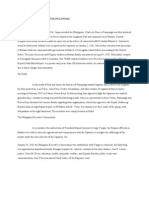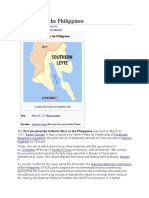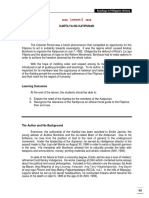The Bataan Death March
The Bataan Death March
Uploaded by
dpattycakesCopyright:
Available Formats
The Bataan Death March
The Bataan Death March
Uploaded by
dpattycakesOriginal Description:
Copyright
Available Formats
Share this document
Did you find this document useful?
Is this content inappropriate?
Copyright:
Available Formats
The Bataan Death March
The Bataan Death March
Uploaded by
dpattycakesCopyright:
Available Formats
The Bataan Death March
The Battle of Bataan ended on April 9, 1942, when U.S. General Edward P. King surrendered to Japanese General Masaharu Homma. At that point 75,000 soldiers became Prisoners of War: about 12,000 Americans and 63,000 Filipinos. What followed was one of the worst atrocities in modern wartime historythe Bataan Death March. During the Battle of Bataan, the American and Filipino soldiers of General Douglas MacArthurs United States Army Forces in the Far East (USAFFE) had held out for four months against the Imperial Japanese Army, while every other island and nation in the Pacific and Southeast Asia fell to the Japanese. By March 1942, Japan controlled all of the Western Pacific except the Philippines. General MacArthurs plan was to hold his ground on the Bataan Peninsula and Corregidor Island in the Philippines until the U.S. Navy could bring reinforcements and supplies from the United States. Once the reinforcements arrived, he planned to attack north from Bataan, defeat the Japanese Army, and push onward to the Japanese islands and victory. But with the U.S. Navy in shambles after the attack on Pearl Harbor, there were no ships capable of bringing the needed reinforcements to Bataan. The Japanese Navy blockaded Bataan and nearby Corregidor, and prevented any food, ammunition or medicine from reaching the U.S. troops. For months the soldiers on Bataan lived on half rations in the hot, tropical jungle. Nevertheless, they fought back against Japanese attacks and defeated the Japanese Army at battles along the Bataan defense line and along the rugged coastline of the peninsula. But without supplies they could barely hold out. By the first of April, 1942, most of the starving men had lost as much as thirty percent of their body weight and they became so weak that they could barely lift their weapons. As medical supplies ran out, malaria, dysentery and other tropical diseases ravaged their ranks. 10,000 men were confined to the two open-air jungle hospitals for wounds and illnesses, and less than half of the remainder could be considered combat effectivedefined as a man who could walk 100 yards without staggering and still have enough strength left to fire his weapon. On April 3, 1942 the Japanese Army launched its final assault on Bataan. Although the starving American and Filipino soldiers fought as best they could, they were no match for the fresh troops the Japanese brought in for the attack. As General Hommas army rolled back the front line on Bataan, General Edward King, the American field commander, made a fateful decisionon April 9 he surrendered rather than see any more of his starving, diseased men slaughtered by the advancing Japanese Army. Once the surrender went into effect, the Japanese rounded up the American and Filipino soldiers and gathered them into groups of 100 on the only paved road that ran down the Bataan peninsula. The
Japanese assigned four guards to each group. They lined the men up four abreast, and they began marching them north toward Camp ODonnell in Tarlac Province, sixty-five miles away. As the emaciated men proceeded north up the highway in the blistering heat, the Japanese guards summarily shot or bayoneted any man who fell, attempted to escape, or stopped to quench his thirst at a roadside spigot or puddle. The men were given little water or food for the entire length of the Bataan Death March, which took about five days for each group to complete. The guards chased off, bayoneted or shot any Filipino civilian who tried to give water or bits of food to the passing lines of prisoners. At various points along the route of the March they singled out prisoners, sometimes in groups, tied them to trees or fences, and shot them to death as examples to the others. The Japanese guards killed between 7,000 and 10,000 men on the Death Marchthey kept no records and no one knows the exact number. If a man fell, it was certain death unless another could pick him up and support him. When they got to their prison camp, Camp ODonnell, conditions were even worse. Camp ODonne ll was a former Philippine Army camp designed to accommodate about 10,000 men. The Japanese crammed 60,000 survivors of the Death March into the camp. There was little running water, sparse food, no medical care, and only slit trenches along the sides of the camp for sanitation. The heat was intolerable, flies rose out of the latrines and covered the prisoners food, and malaria, dysentery, beriberi and a host of other diseases swept through the crowds of men. They began to die at the rate of four hundred per day. It got so bad that by July, 1942, the Japanese replaced the camp commander, moved the American prisoners to another camp, Cabanatuan, and decided to parole the Filipino prisoners.
Name____________
Battle of Bataan and Bataan Death March
By March 1942, Japan controlled all of the Western Pacific except_____________
What did the Japanese Navy do to prevent supplies from reaching US troops at Bataan? ___________________________________________________________ ___________________________________________________________________ Describe the condition of many of the American troops in Bataan. ___________________________________________________________________ ___________________________________________________________________ ___________________________________________________________________ How did the Japanese guards treat the American and Filipino prisoners of war? List a few of the actions taken by the Japanese guards. ___________________________________________________________________ ___________________________________________________________________ ___________________________________________________________________ ___________________________________________________________________ Describe the conditions of the prison camps for those who survived the Death March. ___________________________________________________________________ ___________________________________________________________________ ___________________________________________________________________ ___________________________________________________________________
You might also like
- Japanese Occupation: Between 1941 and 1945Document53 pagesJapanese Occupation: Between 1941 and 1945MCDABCNo ratings yet
- The Fall of BataanDocument2 pagesThe Fall of BataanAnonymous HH3c17osNo ratings yet
- Bataan Death MarchDocument48 pagesBataan Death MarchJosefantastic 75No ratings yet
- Bataan Death March HISTORY RESEARCHDocument2 pagesBataan Death March HISTORY RESEARCHJyNo ratings yet
- Bataan Death MarchDocument2 pagesBataan Death MarchAL CaleNo ratings yet
- Bataan Has FallenDocument4 pagesBataan Has Fallenmilady ekaNo ratings yet
- Tejeros Convention: Artemio RicarteDocument6 pagesTejeros Convention: Artemio RicarteSealtiel1020No ratings yet
- Plaza CuartelDocument12 pagesPlaza CuartelCleverly RazoteNo ratings yet
- DocxDocument8 pagesDocxRiah Mae Merto100% (1)
- Japanese Occupation of The PhilippinesDocument3 pagesJapanese Occupation of The Philippinesare_you_peopleNo ratings yet
- The Philippine RevolutionDocument32 pagesThe Philippine RevolutionBeejay Raymundo100% (1)
- The First FilipinoDocument2 pagesThe First FilipinoRasalyn Cericos ValoisNo ratings yet
- The First Voyage Around The World: Antonio PigafettaDocument23 pagesThe First Voyage Around The World: Antonio PigafettaLeslie OuanoNo ratings yet
- The Declaration of Philippine IndependenceDocument7 pagesThe Declaration of Philippine IndependenceNatasha ChuNo ratings yet
- First Mass in The PhilippinesDocument5 pagesFirst Mass in The PhilippinesDenise PatricioNo ratings yet
- Rhetorical Analysis: Speech of Corazon C. AquinoDocument2 pagesRhetorical Analysis: Speech of Corazon C. AquinoJohn Michael Luzaran ManilaNo ratings yet
- CHAPTER 11 SummaryDocument6 pagesCHAPTER 11 SummaryDenzz QuintalNo ratings yet
- Japanse Era: I. Invasion of JapanDocument40 pagesJapanse Era: I. Invasion of JapanEllah GutierrezNo ratings yet
- History ReportDocument47 pagesHistory ReportVincent Duran Cuzon100% (1)
- Cavite Mutiny On 1872Document10 pagesCavite Mutiny On 1872Allan DavidNo ratings yet
- Module 3. One Past But Many Histories Controversies .... 9 15 2020 PDFDocument32 pagesModule 3. One Past But Many Histories Controversies .... 9 15 2020 PDFEina Delos SantosNo ratings yet
- The First Philippine Republic and The Malolos ConstitutionDocument2 pagesThe First Philippine Republic and The Malolos Constitutionjucsxxx67% (3)
- The Japanese Occupation of The PhilippinesDocument21 pagesThe Japanese Occupation of The PhilippinesDmitri DragunovNo ratings yet
- Antonio PigafettaDocument5 pagesAntonio PigafettaKoji ManlapazNo ratings yet
- Cavity Mutiny 1872 SpanishDocument2 pagesCavity Mutiny 1872 SpanishNikki AllerNo ratings yet
- TH ECR Y of Balintawa K: One Past But Many Histories Controversies and Conflicitng Views in Philippines HistoryDocument7 pagesTH ECR Y of Balintawa K: One Past But Many Histories Controversies and Conflicitng Views in Philippines HistoryThe CarnageNo ratings yet
- Japanese Occupation in PhilippinesDocument23 pagesJapanese Occupation in Philippinesjoseph5689No ratings yet
- Toaz - Info The Assassination of Antonio Luna Reportdocx PRDocument13 pagesToaz - Info The Assassination of Antonio Luna Reportdocx PRMike BibbyNo ratings yet
- Japanese OccupationDocument4 pagesJapanese OccupationRowell CarlosNo ratings yet
- Class ActivityDocument20 pagesClass ActivityJen-jen Corpuz Carpio100% (2)
- Reform and Revolution in The PhilippinesDocument80 pagesReform and Revolution in The Philippinesfayliza87% (23)
- Debate EeeeeDocument6 pagesDebate Eeeeedarkshadowyyy07No ratings yet
- American ColonizationDocument10 pagesAmerican ColonizationJefferson BoadillaNo ratings yet
- Philippine Declaration of Independence: Group 2Document28 pagesPhilippine Declaration of Independence: Group 2ARYATNo ratings yet
- Antonio Pigafetta's First Voyage Around The World: A TravelogueDocument3 pagesAntonio Pigafetta's First Voyage Around The World: A TravelogueGerome RosarioNo ratings yet
- Historical Interpretations in Philippine History. Spaces For Conflict and Controversies W3P1Document24 pagesHistorical Interpretations in Philippine History. Spaces For Conflict and Controversies W3P1Maria Reynagie OgueNo ratings yet
- 4TH Activity 6Document4 pages4TH Activity 6ALEX JR. BUCASENNo ratings yet
- Lesson 6.0 The Act of Proclamation of Independence of The Filipino PeopleDocument10 pagesLesson 6.0 The Act of Proclamation of Independence of The Filipino PeopleQuinnie CervantesNo ratings yet
- Filipino Grievances Against Governor Wood (Handout)Document1 pageFilipino Grievances Against Governor Wood (Handout)Jan Marie EscurelNo ratings yet
- Act of ProclamationDocument14 pagesAct of ProclamationAndrea MoniqueNo ratings yet
- JPL Prelims ReviewerDocument9 pagesJPL Prelims ReviewerBenedict CastilloNo ratings yet
- Rise of Filipino NationalismDocument68 pagesRise of Filipino NationalismDANIELLA JOIZ MARI DIAZNo ratings yet
- Japanese Occupation in The PhilippinesDocument68 pagesJapanese Occupation in The PhilippinesMark Raphael DeticioNo ratings yet
- Antonio FigapetaDocument22 pagesAntonio Figapetakurou hazama100% (1)
- INDEPENDENCEDocument2 pagesINDEPENDENCESHAINA ANNE BUENAVIDESNo ratings yet
- Siquijor Written ReportDocument25 pagesSiquijor Written ReportadventurasturismophNo ratings yet
- Philippines During Japanese OccupationDocument21 pagesPhilippines During Japanese OccupationRoldan Agad SarenNo ratings yet
- Module 2 - Lesson 6 The Act of Declaration of Philippine IndependenceDocument25 pagesModule 2 - Lesson 6 The Act of Declaration of Philippine IndependencecaratarmyblinkNo ratings yet
- The Magellan ExpeditionDocument25 pagesThe Magellan Expeditionmerwin manucumNo ratings yet
- Indolence of The FilipinosDocument3 pagesIndolence of The Filipinoskurou hazamaNo ratings yet
- CHAPTER 12 - The Philippines Under The American RuleDocument72 pagesCHAPTER 12 - The Philippines Under The American RuleCONCORDIA RAFAEL IVAN100% (1)
- G. R IN Phil History Mod 1 Week 6 - 2020-2021 - RealDocument7 pagesG. R IN Phil History Mod 1 Week 6 - 2020-2021 - RealShinTaxErrorNo ratings yet
- Cavite Mutiny Rizal ReportDocument9 pagesCavite Mutiny Rizal ReportAmy SarausaNo ratings yet
- Kartilya NG KatipunanDocument5 pagesKartilya NG KatipunanNorlyn Joy InsigneNo ratings yet
- The Philippine Declaration of Independence Occurred On June 12Document4 pagesThe Philippine Declaration of Independence Occurred On June 12Moises R Tordilla III63% (8)
- Bataan Death March: Lead-Up To The MarchDocument5 pagesBataan Death March: Lead-Up To The MarchBlaster SilongaNo ratings yet
- Bataan Death MarchDocument1 pageBataan Death MarchHasz RonquilloNo ratings yet
- Bataan Death MarchDocument2 pagesBataan Death MarchYdnar Christian BaldelovarNo ratings yet
- The Battle of MactanDocument5 pagesThe Battle of MactantarceljoyNo ratings yet
- Classroom Management PlanDocument11 pagesClassroom Management PlanMrPattersonNo ratings yet
- Parent Contact DescriptionsDocument6 pagesParent Contact DescriptionsdpattycakesNo ratings yet
- U.S. in The Pacific - Lesson PlanDocument3 pagesU.S. in The Pacific - Lesson PlandpattycakesNo ratings yet
- Apartheid - Unit Pacing CalendarDocument3 pagesApartheid - Unit Pacing CalendardpattycakesNo ratings yet
- Warm UpDocument1 pageWarm UpdpattycakesNo ratings yet
- Apartheid - Unit PlanDocument19 pagesApartheid - Unit PlandpattycakesNo ratings yet
- WW2 Home Front TermsDocument5 pagesWW2 Home Front TermsdpattycakesNo ratings yet
- In Defense of The Prophet MuhammadDocument4 pagesIn Defense of The Prophet MuhammadShadab AnjumNo ratings yet
- Schubert Other Than WarDocument140 pagesSchubert Other Than WarantoniocaraffaNo ratings yet
- Self Defence PIL (Legal Issues??)Document13 pagesSelf Defence PIL (Legal Issues??)ebba.lemma10No ratings yet
- (DO2019) El AlameinDocument1 page(DO2019) El AlameinRaúlNo ratings yet
- Imagine - Beatles Reaction PaperDocument1 pageImagine - Beatles Reaction PaperAmiel D. FanerNo ratings yet
- International Relations Meaning Definition and ScopeDocument14 pagesInternational Relations Meaning Definition and Scopeerum100% (1)
- WW2 Cornell NotesDocument12 pagesWW2 Cornell NotesKasem Ahmed100% (2)
- Victorys Foundation - US Logistical Support of The Allied MediterDocument540 pagesVictorys Foundation - US Logistical Support of The Allied MeditermettracortdiagnosticoNo ratings yet
- Origins of The Cold WarDocument2 pagesOrigins of The Cold Warapi-302655029No ratings yet
- New Roster (498pts) : Eldar Craftworlds: Codex (2015) (Combined Arms Detachment) (498pts)Document3 pagesNew Roster (498pts) : Eldar Craftworlds: Codex (2015) (Combined Arms Detachment) (498pts)Anonymous AQpdPNGZaNo ratings yet
- Counting The DeadDocument3 pagesCounting The DeadaeriedouglasNo ratings yet
- Pols 102 Nov 2014 MainDocument20 pagesPols 102 Nov 2014 Mainpkay pauloNo ratings yet
- Command in War: Martin Van CreveldDocument1 pageCommand in War: Martin Van CreveldPete Maverick MitchellNo ratings yet
- The Theme of Violence in The Shadow Lines'Document12 pagesThe Theme of Violence in The Shadow Lines'surbhi sabharwalNo ratings yet
- FM 27-10, 25 April 1914Document222 pagesFM 27-10, 25 April 1914EheyehAsherEheyehNo ratings yet
- Security : The Palme Commission DisarmamentDocument5 pagesSecurity : The Palme Commission DisarmamentVictorTeodoroNo ratings yet
- Nuclear Policy of IndiaDocument4 pagesNuclear Policy of IndiaArkaj KumarNo ratings yet
- Scientific Principles of Improvised Warfare and Home Defense - Vol 5 - Chemical Weapons - TobiasonDocument198 pagesScientific Principles of Improvised Warfare and Home Defense - Vol 5 - Chemical Weapons - TobiasonAlan RoguzNo ratings yet
- Rifle Marksmanship: MCRP 3-1ADocument124 pagesRifle Marksmanship: MCRP 3-1An2jesusNo ratings yet
- Billhooks: Further Faqs and New Gaming Aids: by Ndy Allan ArtDocument4 pagesBillhooks: Further Faqs and New Gaming Aids: by Ndy Allan ArtMarkNo ratings yet
- In The News: World War 3Document2 pagesIn The News: World War 3Thomas ScottNo ratings yet
- Thesis On Private Military CompaniesDocument5 pagesThesis On Private Military Companiesnicolecochranerie100% (2)
- 3 Fallschirmjager Division Normandy PDFDocument3 pages3 Fallschirmjager Division Normandy PDFdelpoNo ratings yet
- Forms of Social Life, InteractionDocument27 pagesForms of Social Life, InteractionVidhi BansalNo ratings yet
- Getachow GelanaDocument36 pagesGetachow GelanaAmmanNo ratings yet
- Gundamand MOWDocument99 pagesGundamand MOWkarl koNo ratings yet
- Nato Expansion Flashpoint No. 3: Kaliningrad, Cato Foreign Policy BriefingDocument21 pagesNato Expansion Flashpoint No. 3: Kaliningrad, Cato Foreign Policy BriefingCato InstituteNo ratings yet
- This Electronic Thesis or Dissertation Has Been Downloaded From The King's Research Portal atDocument447 pagesThis Electronic Thesis or Dissertation Has Been Downloaded From The King's Research Portal atGustavo FernettiNo ratings yet
- TerrorismDocument6 pagesTerrorismKamisha FabianNo ratings yet
- Osprey - Battle Orders 011 - US Army Forces in The Korean War 1950-53Document99 pagesOsprey - Battle Orders 011 - US Army Forces in The Korean War 1950-53Maurits Huijbrechtse100% (2)
































































































